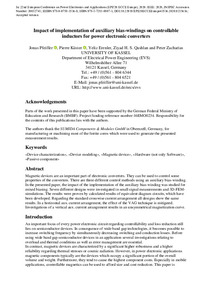Konferenzveröffentlichung

Impact of implementation of auxiliary bias-windings on controllable inductors for power electronic converters
Zusammenfassung
Magnetic devices are an important part of electronic converters. They can be used to control some properties of the converters. There are three different control methods using an auxiliary bias-winding. In the presented paper, the impact of the implementation of the auxiliary bias-winding was studied for mixed biasing. Seven different designs were investigated in small signal measurements and 3D-FEM-simulations. The results were proven by calculated results of equivalent diagram circuits, which have been developed. Regarding the standard crosswise current arrangement all designs show the same results. In a horizontal aux. current arrangement, the effect of the VAG technique is mitigated. Investigations of a vertical aux. current arrangement results in an unsymmetrical magnetization curve.
Zitierform
In: (Hrsg.): 22nd European Conference on Power Electronics and Applications (EPE'20 ECCE Europe). IEEE: Piscataway, New Jersey 2020, S. P.1-P.10; eisbn:978-9-0758-1536-8, isbn:978-1-7281-9807-1Zusätzliche Informationen
The authors thank the SUMIDA Components & Modules GmbH in Obernzell, Germany, for manufacturing or machining most of the ferrite cores which were used to generate the presented measurement results. Proceedings of the 22nd European Conference on Power Electronics and Applications (EPE'20 ECCE Europe), held 7-11 September 2020 in Lyon, France.Förderhinweis
Parts of the work presented in this paper have been supported by the German Federal Ministry of Education and Research (BMBF). Project funding reference number: 16EMO0234.Zitieren
@inproceedings{doi:10.17170/kobra-202108314671,
author={Pfeiffer, Jonas and Küster, Pierre and Erenler, Yeliz and Qashlan, Ziyad H. S. and Zacharias, Peter},
title={Impact of implementation of auxiliary bias-windings on controllable inductors for power electronic converters},
booktitle={22nd European Conference on Power Electronics and Applications (EPE'20 ECCE Europe)},
year={2020}
}
0500 Oax
0501 Text $btxt$2rdacontent
0502 Computermedien $bc$2rdacarrier
1100 2020$n2020
1500 1/eng
2050 ##0##http://hdl.handle.net/123456789/13243
3000 Pfeiffer, Jonas
3010 Küster, Pierre
3010 Erenler, Yeliz
3010 Qashlan, Ziyad H. S.
3010 Zacharias, Peter
4000 Impact of implementation of auxiliary bias-windings on controllable inductors for power electronic converters / Pfeiffer, Jonas
4030
4060 Online-Ressource
4085 ##0##=u http://nbn-resolving.de/http://hdl.handle.net/123456789/13243=x R
4204 \$dKonferenzveröffentlichung
4170
5550 {{Konverter <Elektronik>}}
5550 {{Transduktor}}
5550 {{Elektromagnet}}
5550 {{Steuergerät}}
7136 ##0##http://hdl.handle.net/123456789/13243
<resource xsi:schemaLocation="http://datacite.org/schema/kernel-2.2 http://schema.datacite.org/meta/kernel-2.2/metadata.xsd"> 2021-09-14T16:08:44Z 2021-09-14T16:08:44Z 2020 doi:10.17170/kobra-202108314671 http://hdl.handle.net/123456789/13243 The authors thank the SUMIDA Components & Modules GmbH in Obernzell, Germany, for manufacturing or machining most of the ferrite cores which were used to generate the presented measurement results. Proceedings of the 22nd European Conference on Power Electronics and Applications (EPE'20 ECCE Europe), held 7-11 September 2020 in Lyon, France. Parts of the work presented in this paper have been supported by the German Federal Ministry of Education and Research (BMBF). Project funding reference number: 16EMO0234. eng IEEE Urheberrechtlich geschützt https://rightsstatements.org/page/InC/1.0/ magnetic device passive component device characterisation device modelling hardware (not only software) 620 Impact of implementation of auxiliary bias-windings on controllable inductors for power electronic converters Konferenzveröffentlichung Magnetic devices are an important part of electronic converters. They can be used to control some properties of the converters. There are three different control methods using an auxiliary bias-winding. In the presented paper, the impact of the implementation of the auxiliary bias-winding was studied for mixed biasing. Seven different designs were investigated in small signal measurements and 3D-FEM-simulations. The results were proven by calculated results of equivalent diagram circuits, which have been developed. Regarding the standard crosswise current arrangement all designs show the same results. In a horizontal aux. current arrangement, the effect of the VAG technique is mitigated. Investigations of a vertical aux. current arrangement results in an unsymmetrical magnetization curve. open access Pfeiffer, Jonas Küster, Pierre Erenler, Yeliz Qashlan, Ziyad H. S. Zacharias, Peter Piscataway, New Jersey doi:10.23919/EPE20ECCEEurope43536.2020.9215616 BMBF 16EMO0234 Konverter <Elektronik> Transduktor Elektromagnet Steuergerät acceptedVersion 22nd European Conference on Power Electronics and Applications (EPE'20 ECCE Europe) eisbn:978-9-0758-1536-8 isbn:978-1-7281-9807-1 P.1-P.10 false 20032741 </resource>
Die folgenden Lizenzbestimmungen sind mit dieser Ressource verbunden:
Urheberrechtlich geschützt

